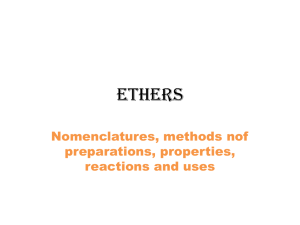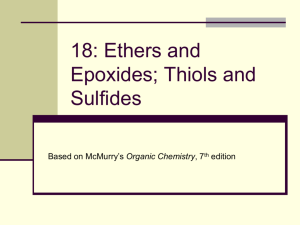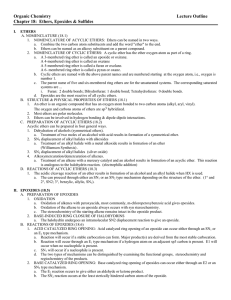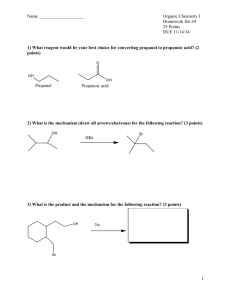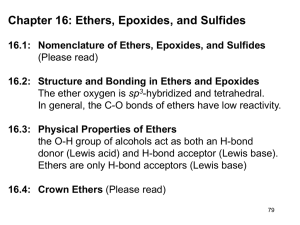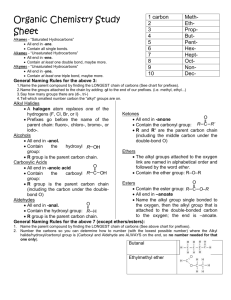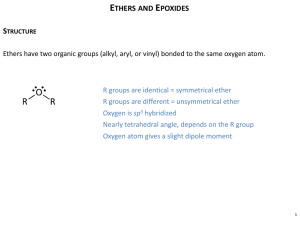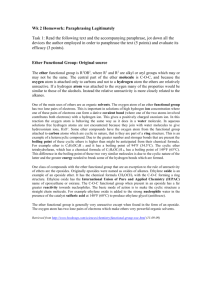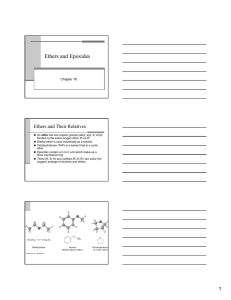Ethers and Epoxides - Delaware State University
advertisement
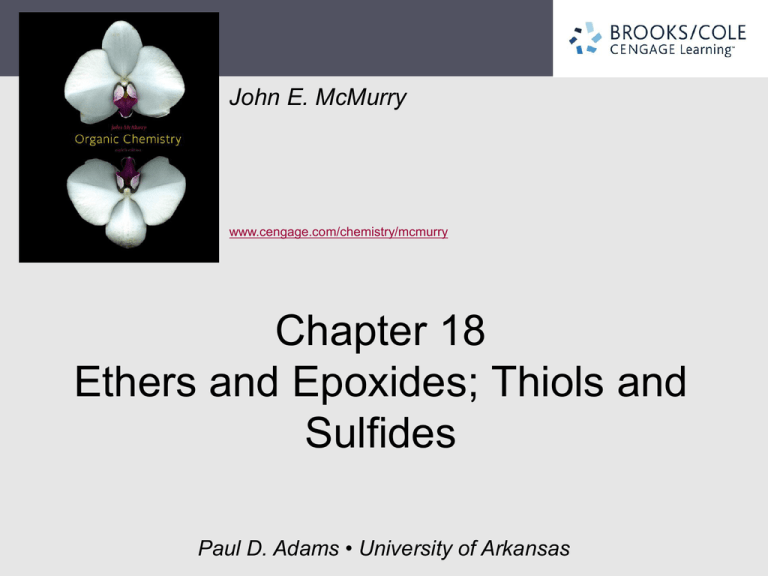
John E. McMurry www.cengage.com/chemistry/mcmurry Chapter 18 Ethers and Epoxides; Thiols and Sulfides Paul D. Adams • University of Arkansas Ethers and Their Relatives An ether has two organic groups (alkyl, aryl, or vinyl) bonded to the same oxygen atom, R–O–R Diethyl ether is used industrially as a solvent Tetrahydrofuran (THF) is a solvent that is a cyclic ether Thiols (R–S–H) and sulfides (R–S–R) are sulfur (for oxygen) analogues of alcohols and ethers Why this Chapter? To finish covering functional groups with C-O and C-S single bonds Focus on ethers and look at thiols and sulfides before going on to C=O 18.1 Names and Properties of Ethers Simple ethers are named by identifying the two organic substituents and adding the word ether If other functional groups are present, the ether part is considered an alkoxy substituent R–O–R ~ tetrahedral bond angle (112° in dimethyl ether) Oxygen is sp3-hybridized Oxygen atom gives ethers a slight dipole moment 18.2 Synthesis of Ethers Diethyl ether prepared industrially by sulfuric acid–catalyzed dehydration of ethanol – also with other primary alcohols The Williamson Ether Synthesis Reaction of metal alkoxides and primary alkyl halides and tosylates Best method for the preparation of ethers Alkoxides prepared by reaction of an alcohol with a strong base such as sodium hydride, NaH Silver Oxide-Catalyzed Ether Formation Reaction of alcohols with Ag2O directly with alkyl halide forms ether in one step Glucose reacts with excess iodomethane in the presence of Ag2O to generate a pentaether in 85% yield Alkoxymercuration of Alkenes React alkene with an alcohol and mercuric acetate or trifluoroacetate Demercuration with NaBH4 yields an ether Overall Markovnikov addition of alcohol to alkene 18.3 Reactions of Ethers: Acidic Cleavage Ethers are generally unreactive Strong acid will cleave an ether at elevated temperature HI, HBr produce an alkyl halide from less hindered component by SN2 (tertiary ethers undergo SN1) 18.4 Reactions of Ethers: Claisen Rearrangement Specific to allyl aryl ethers, ArOCH2CH=CH2 Heating to 200–250°C leads to an o-allylphenol Result is alkylation of the phenol in an ortho position Claisen Rearrangement Mechanism Concerted pericyclic 6-electron, 6-membered ring transition state Mechanism consistent with 14C labeling 18.5 Cyclic Ethers Cyclic ethers behave like acyclic ethers, except if ring is 3-membered Dioxane and tetrahydrofuran are used as solvents Epoxides (Oxiranes) Three membered ring ether is called an oxirane (root “ir” from “tri” for 3-membered; prefix “ox” for oxygen; “ane” for saturated) Also called epoxides Ethylene oxide (oxirane; 1,2-epoxyethane) is industrially important as an intermediate Prepared by reaction of ethylene with oxygen at 300 °C and silver oxide catalyst Preparation of Epoxides Using a Peroxyacid Treat an alkene with a peroxyacid Epoxides from Halohydrins Addition of HO-X to an alkene gives a halohydrin Treatment of a halohydrin with base gives an epoxide Intramolecular Williamson ether synthesis 18.6 Reactions of Epoxides: Ring-Opening Water adds to epoxides with dilute acid at room temperature Product is a 1,2-diol (on adjacent C’s: vicinal) Mechanism: acid protonates oxygen and water adds to opposite side (trans addition) Halohydrins from Epoxides Anhydrous HF, HBr, HCl, or HI combines with an epoxide Gives trans product Regiochemistry of Acid-Catalyzed Opening of Epoxides Nucleophile preferably adds to less hindered site if primary and secondary C’s Also at tertiary because of carbocation character Base-Catalyzed Epoxide Opening Strain of the three-membered ring is relieved on ringopening Hydroxide cleaves epoxides at elevated temperatures to give trans 1,2-diols Addition of Grignards to Ethylene Oxide Adds –CH2CH2OH to the Grignard reagent’s hydrocarbon chain Acyclic and other larger ring ethers do not react 18.7 Crown Ethers Large rings consisting of repeating (-OCH2CH2-) or similar units Named as x-crown-y x is the total number of atoms in the ring y is the number of oxygen atoms 18-crown-6 ether: 18-membered ring containing 6 oxygen atoms Central cavity is electronegative and attracts cations 18.8 Thiols and Sulfides Thiols (RSH), are sulfur analogues of alcohols Named with the suffix -thiol SH group is called “mercapto group” (“capturer of mercury”) Thiols: Formation and Reaction From alkyl halides by displacement with a sulfur nucleophile such as –SH The alkylthiol product can undergo further reaction with the alkyl halide to give a symmetrical sulfide, giving a poorer yield of the thiol Sulfides Sulfides (RSR), are sulfur analogues of ethers Named by rules used for ethers, with sulfide in place of ether for simple compounds and alkylthio in place of alkoxy Using Thiourea to Form Alkylthiols Thiols can undergo further reaction with the alkyl halide to give dialkyl sulfides For a pure alkylthiol use thiourea (NH2(C=S)NH2) as the nucleophile This gives an intermediate alkylisothiourea salt, which is hydrolyzed cleanly to the alkyl thiourea Oxidation of Thiols to Disulfides Reaction of an alkyl thiol (RSH) with bromine or iodine gives a disulfide (RSSR) The thiol is oxidized in the process and the halogen is reduced Sulfides Thiolates (RS) are formed by the reaction of a thiol with a base Thiolates react with primary or secondary alkyl halide to give sulfides (RSR’) Thiolates are excellent nucleophiles and react with many electrophiles Sulfides as Nucleophiles Sulfur compounds are more nucleophilic than their oxygen-compound analogues 3p valence electrons (on S) are less tightly held than 2p electrons (on O) Sulfides react with primary alkyl halides (SN2) to give trialkylsulfonium salts (R3S+) Oxidation of Sulfides Sulfides are easily oxidized with H2O2 to the sulfoxide (R2SO) Oxidation of a sulfoxide with a peroxyacid yields a sulfone (R2SO2) Dimethyl sulfoxide (DMSO) is often used as a polar aprotic solvent 18.9 Spectroscopy of Ethers Infrared: C–O single-bond stretching 1050 to 1150 cm1 overlaps many other absorptions. Proton NMR: H on a C next to ether O is shifted downfield to 3.4 to 4.5 The 1H NMR spectrum of dipropyl ether shows this signal at 3.4 In epoxides, these H’s absorb at 2.5 to 3.5 in their 1H NMR spectra Carbon NMR: C’s in ethers exhibit a downfield shift to 50 to 80 Let’s Work a Problem When 2-methyl-2,5-pentanediol is treated with sulfuric acid, dehydration occurs and 2,2dimethyltetrahydrofuran is formed. Suggest a mechanism for this reaction. Which of the two oxygen atoms is most likely to be eliminated and why? Answer First, there is protonation of the 3˚ –OH group, then a 3˚ carbocation is formed via loss of H2O. Then there is a nucleophilic attack of the carbocation by the 2nd –OH group. The 3˚ OH group is the one eliminated in all likelihood because its removal involves the formation of the more stable 3˚ carbocation.
